Things That Are Blue List Things That Are Blue
Blue things: Welcome to our visual list of things that are blue.
It may be one of the rarest colors in nature, but blue things can still be found everywhere around us if we're only willing to look.
From the most vibrant and obvious splashes of color found in bird's wings or flower petals to the kind of muted tones we may only notice on occasion, the world is bursting with blue.
List of Things That Are Blue
Here's our extensive list of things that are blue in nature:
1. The Sky

Because of the way different wavelengths of light are scattered and absorbed as they move through the atmosphere, blue light is the most visible wavelength in the sky.
2. The Ocean
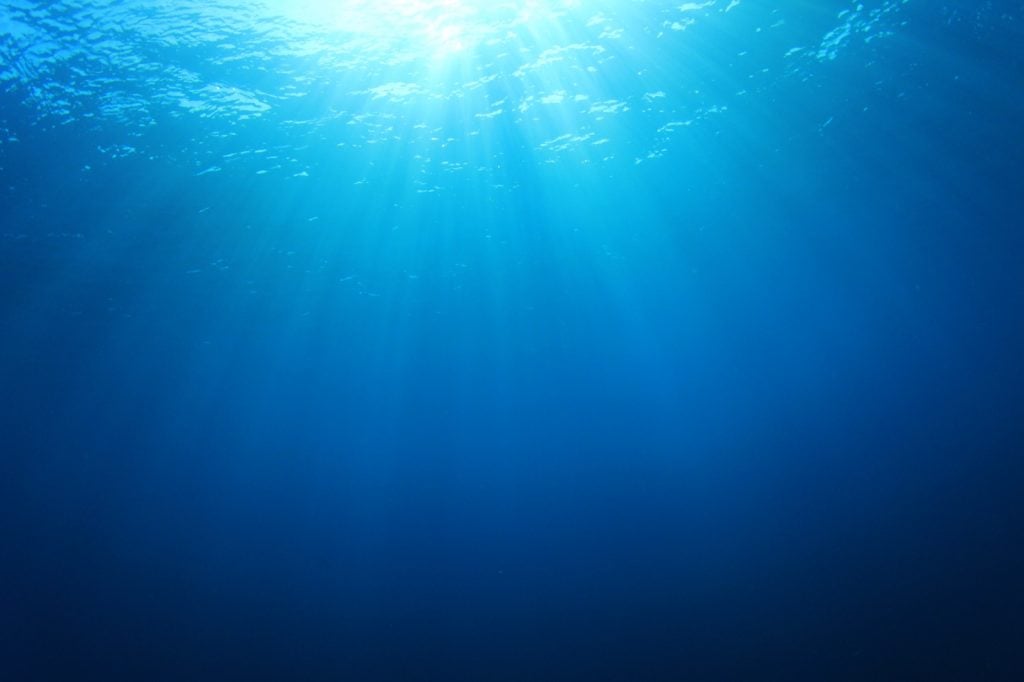
The ocean doesn't have much of a color on its own, but on sunny days, when it reflects the color of the sky above, it's a brilliant blue.
3. Fire

We may think of flames as being orange or red, but depending on the type of fuel being used, gas flames can take on a bright blue hue. Some volcanos also have blue flames and lava when sulfur combusts in contact with air.
4. Blue Eyes

Only around eight to ten percent of people worldwide have blue eyes, and every blue-eyed person can trace their uniquely colored eyes back to a single genetic mutation. Blue eyes have no actual blue pigment, but they scatter light differently to produce a blue appearance.
5. Blueberries

Blueberries are native to North America and are packed with antioxidants and tons of other powerful vitamins that make them great for people looking to boost heart health.
6. Cornflowers

Cornflowers, with their bright blue petals, are originally native to Europe and were commonly seen growing as a weed in cornfields, which is where they got their name.
7. Thistles

Most thistles have purple or even slightly pinkish flowers, but the Globe Thistle, native to Europe, Central Asia, and North Africa, have petals with a soft blue hue. The thistle is the national flower of Scotland and its spiky leaves are reported to have stopped an invading army in legend.
8. Butterflies
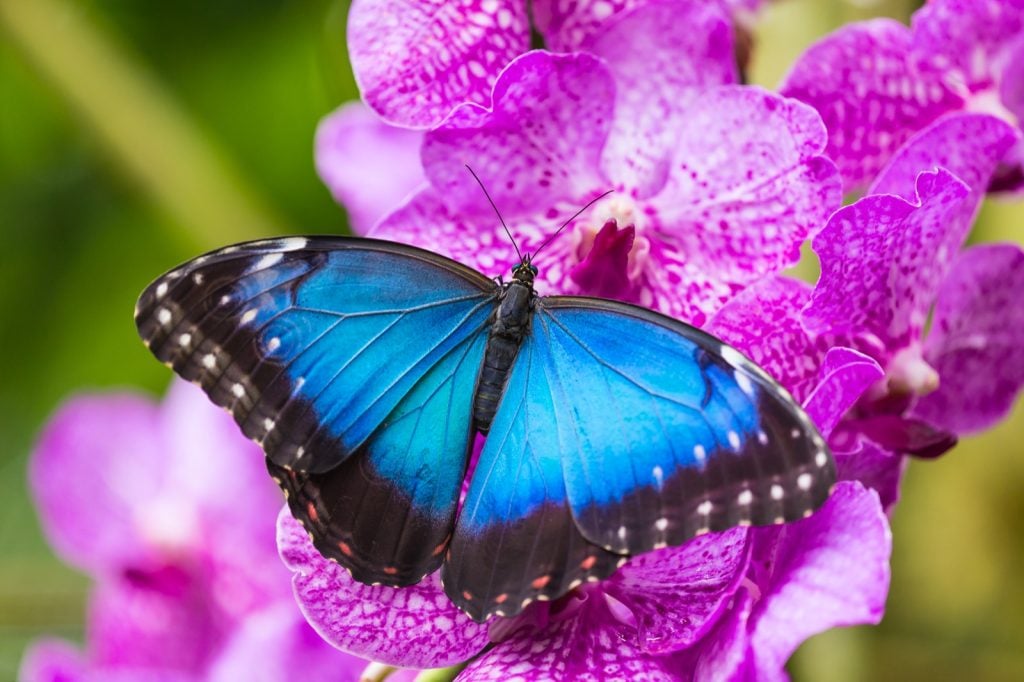
Several exotic breeds of butterfly, including the Emperor Butterfly, the Morpho Butterfly, the Mazarine Blue Butterfly, the Ulysses Butterfly, and the Miami Blue Butterfly, have bright blue wings.
9. Dart Frogs
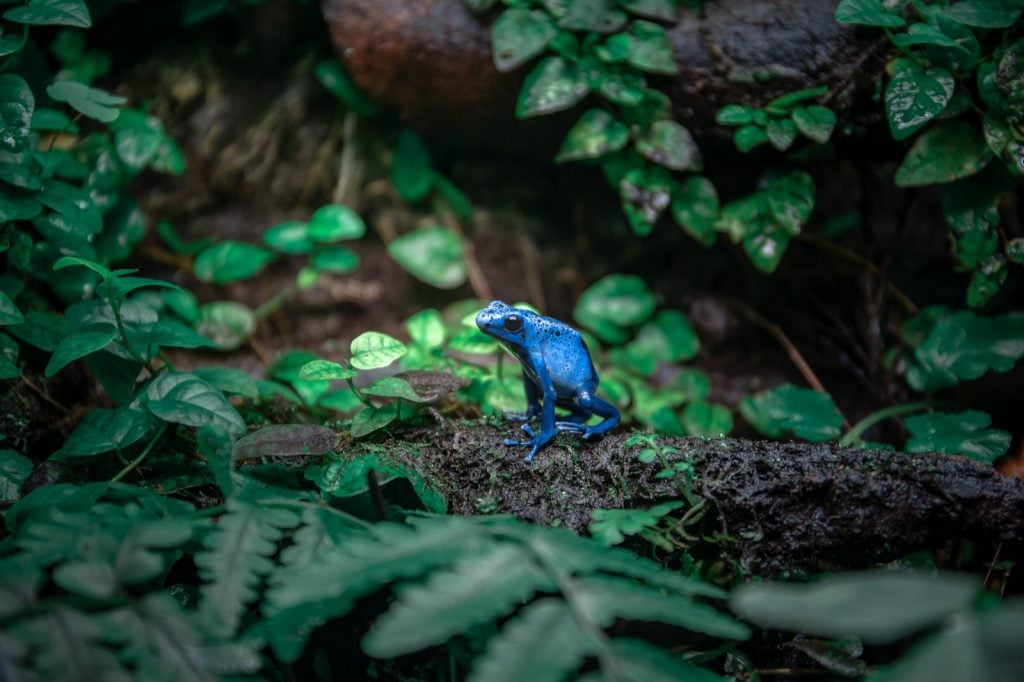
Native to the rain forests of South America, the Dart Frog has enough poison in its skin to kill twenty men, although the poison also has medicinal properties.
10. Blue-Footed Booby

Their actual feathers may be a plain brown and white, but the eponymous webbed feet of the blue-footed booby have a pale, robin's egg blue color to them.
11. Hyacinths

Hyacinth flowers have a deep blue or pale purple color. The ancient Greeks believed that this flower sprang from the body of the heroic youth Hyacinthus after his death.
12. Neptune
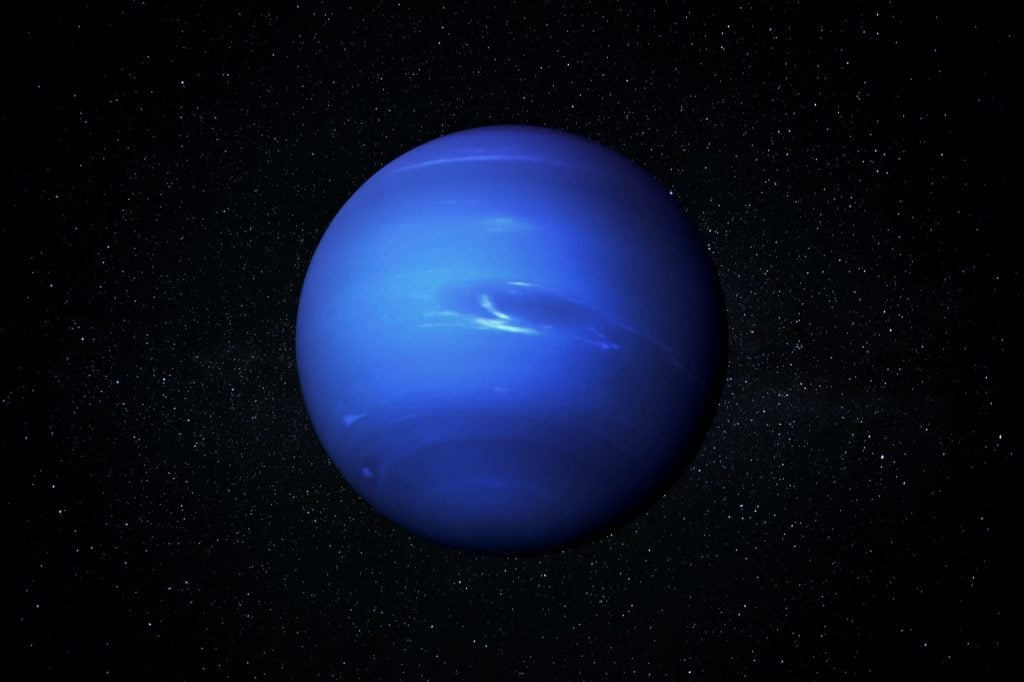
The atmosphere of the planet Neptune has lots of methane, which partially explains its blue tone, but the majority of the deeper colors come from an unknown compound.
13. Uranus

Uranus's pale blue color comes from the large amounts of methane, ammonia, and other similarly gaseous elements that make up its upper atmosphere.
14. Tomatoes
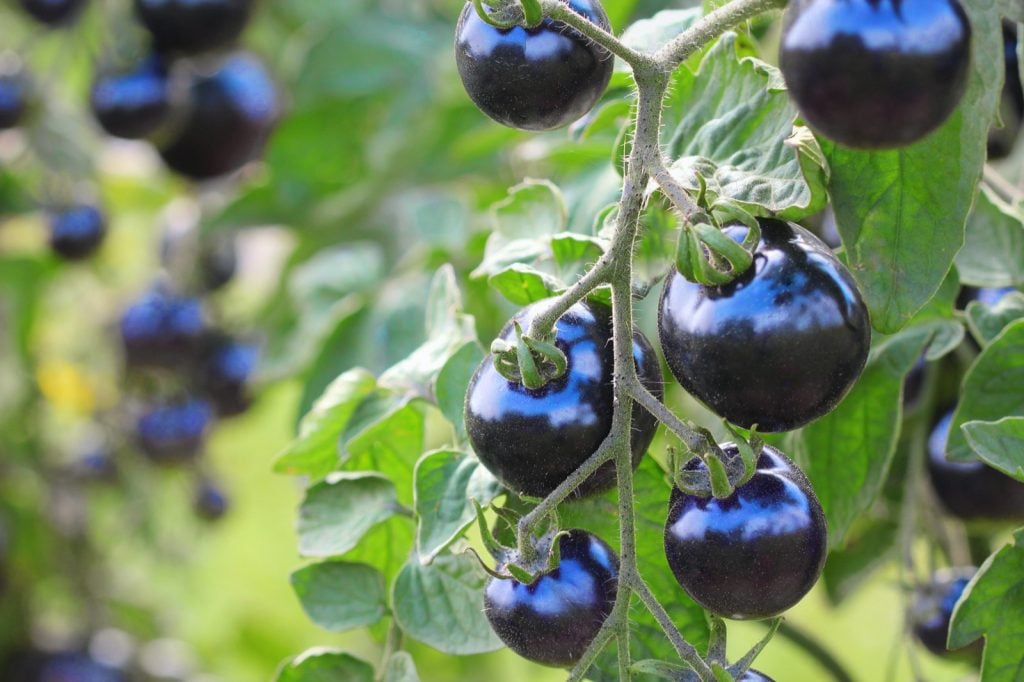
Truly "blue" tomatoes are carefully bred and modified in order to reach the same color as blueberries, but blue-black tomatoes occasionally occur as the result of a mutation.
15. Hibiscuses

When we think of hibiscus flowers, we tend to imagine the bright red version. However, blue "hibiscuses" are actually a type of lily that closely resemble real hibiscuses.
16. Anemones

Although sea anemones can certainly be blue, we're talking about anemone flowers. These small flowers come in blue, red, and other colors and are found throughout the world.
17. Robin's Eggs

Long before it was a popular paint color, the distinctive blue-green color of robin's eggs have been a splash of brightness from an otherwise drab bird.
18. Peacocks

They may have a lot of different colors in that iconic spreading tail of theirs, but the feathers of a male peacock's coat boast an unmistakably blue note.
19. Kingfishers

Kingfishers are found in Oceania, Asia, and Africa. Their bright blue coats make them instantly recognizable, and they play prominent roles in the myths and legends of many cultures.
20. Hyacinth Macaws

Despite its name, the Hyacinth Macaw is actually a much darker blue than the traditional hyacinth flower. It's also the largest macaw and the largest flying parrot worldwide.
21. Crayfish

The electric blue crayfish is native to Florida. Also referred to as the Florida Blue Crayfish, this popular aquarium crustacean isn't found anywhere else in the natural world.
22. Turquoise

The cheerful bluish green tint of this semi-precious gemstone once made it one of the most valuable stones in the ancient world, beloved by the Greeks and Aztecs.
23. Bluebonnets

Named after the petals that resemble an old-fashioned woman's bonnet, the bluebonnet is actually a family of flowers, the most famous variety being the state flower of Texas.
24. Lobsters

Most of the time, lobsters definitely aren't blue. However, a one-in-two-million genetic mutation can result in a completely natural lobster that happens to be a bright electric blue.
25. Blue Racer Snakes
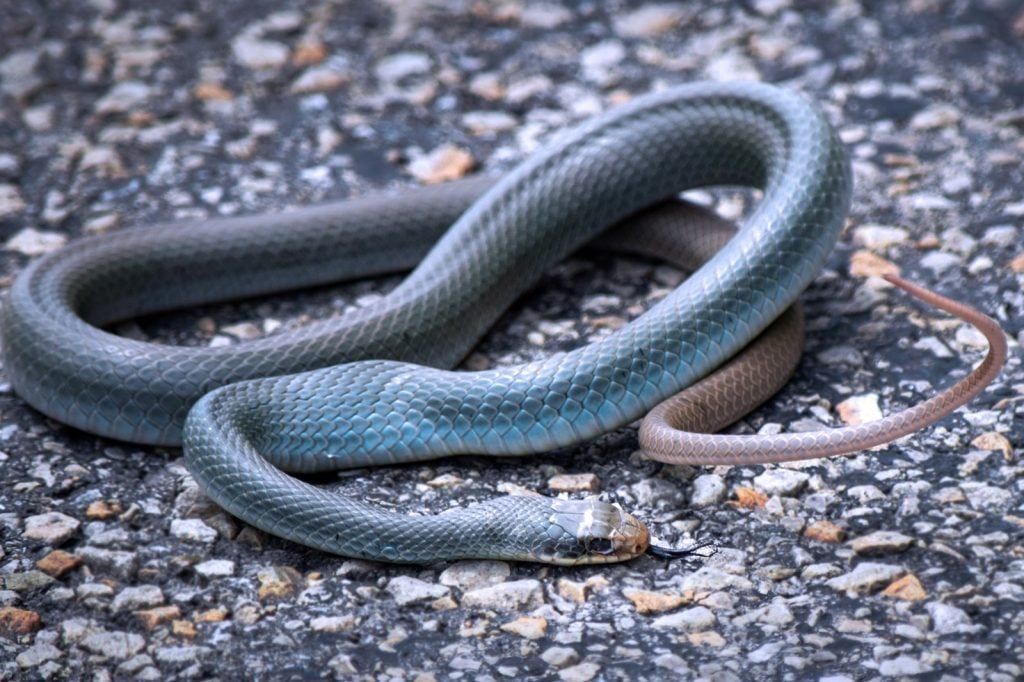
Mostly grayish-blue with blue highlights, these non-venomous snakes often rattle their tails against dry leaves in order to frighten predators away by imitating the far more deadly rattlesnake.
26. Starfish
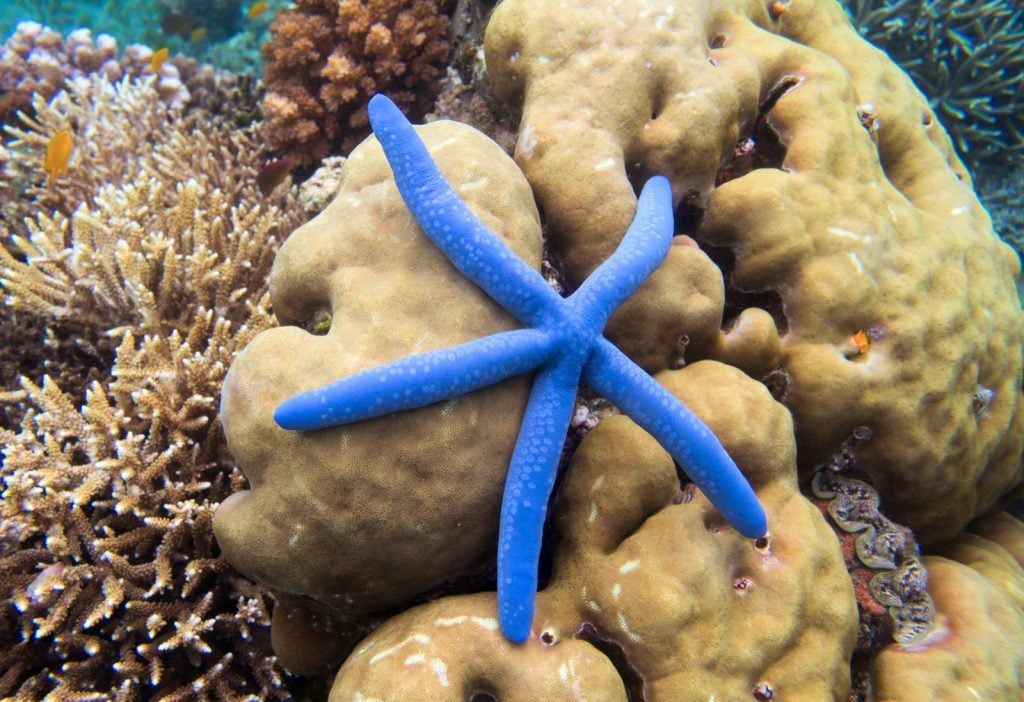
The blue Linckia Sea Star lives throughout the shallow waters of the Indo-Pacific Ocean and ranges in color from pale blue to electric blue to deep royal blue.
27. Steelblue Ladybugs

The Steelblue Ladybird is an Australian beetle that resembles the more common "ladybug" beetle. Its outer coating has a metallic blue sheen, and it preys on other insects.
28. Siamese Fighting Fish

Siamese Fighting Fish or Betta Fish are some of the most popular aquarium fish in the world. The scales of many often take on a vibrant blue hue.
29. Tree Swallows
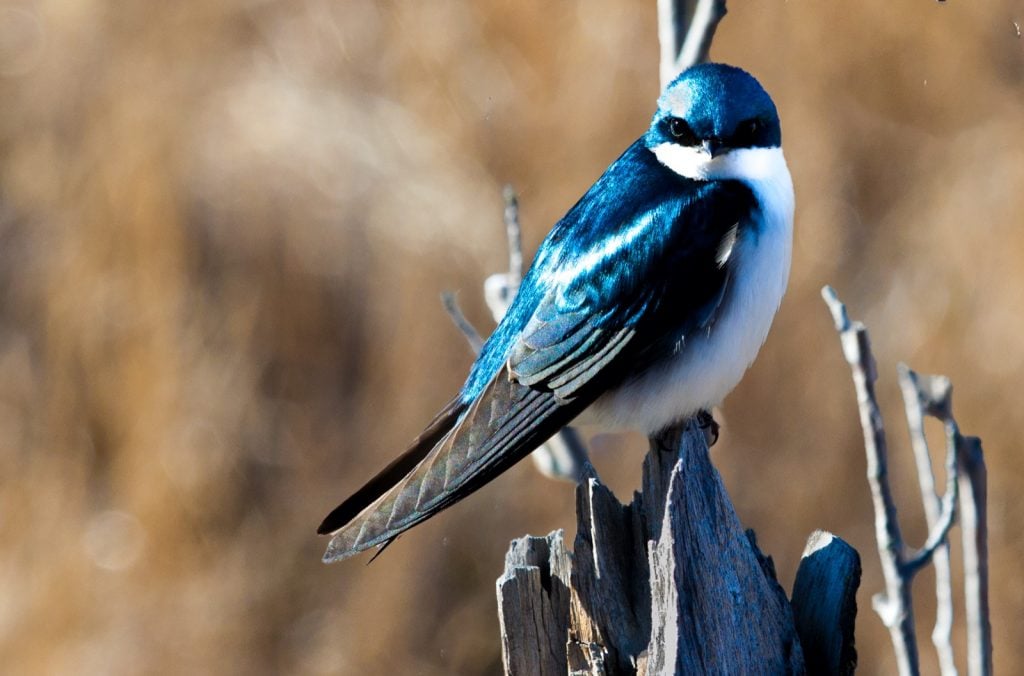
Tree Swallows, native to most of North America, have dramatic blue and white feathers. This stark color contrast serves as a form of camouflage when seen from above.
30. Blue Tangs
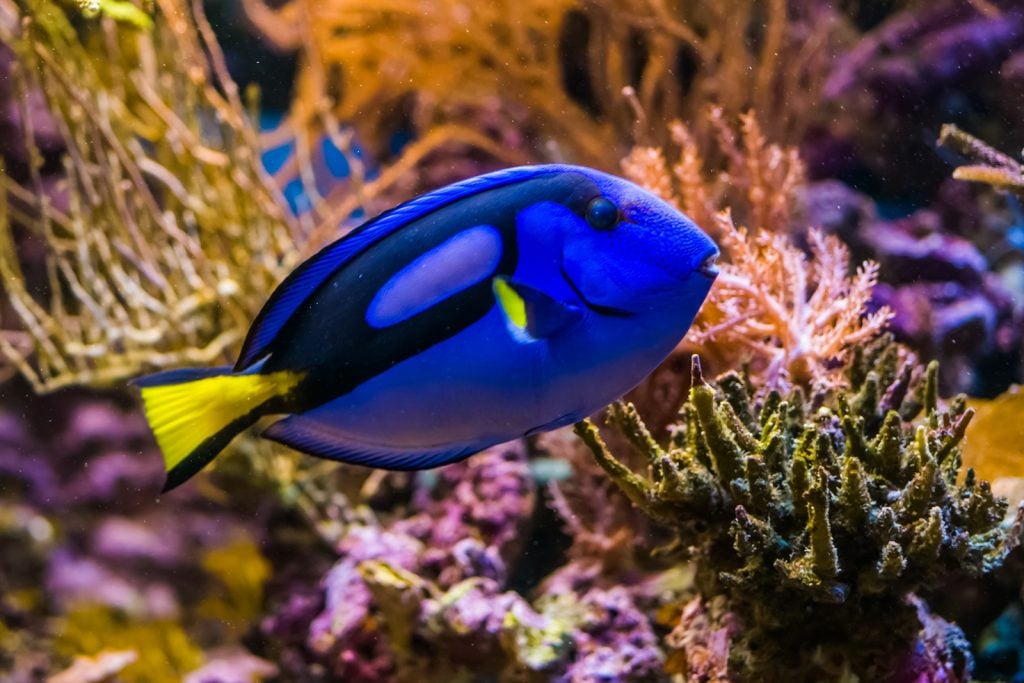
Native to the Indo-Pacific Ocean and popularized by the Pixar movie Finding Nemo, Blue Tangs have bright royal blue scales and are commonly found in aquariums around the world.
31. Blue-Ringed Octopus

The blue-ringed octopus isn't actually blue, but instead features blue spots covering its body that give it its name. It's also one of the most venomous animals worldwide.
32. Iguanas

Only the males of the Blue Iguana species are truly blue, with colors ranging from bright turquoise blue to dark gray. The females are varying shades of green.
33. Sharks

Long and slim, Blue Sharks rely heavily on countershading for protection. Their darker backs and lighter stomachs help them blend in better whether viewed from above or below.
34. Blue Whales

Like most sea creatures, the Blue Whale's definition of "blue" tends a little more towards gray than true blue. They are the largest animals existing on the planet.
35. Ribbon Eels

The Ribbon Eel has a sharp, pointed nose, a bright yellow stripe along its dorsal fin – and a jet black skin that turns to blue as they age.
36. Blue Spotted Puffer Fish

Like the similarly named octopus, the Blue Spotted Puffer Fish is actually tan in color, but features a series of small blue spots along its sides and head.
37. Sea Slugs

They come in a wide range of colors and patterns, so it should come as no real surprise that some Sea Slugs boast bright blue coloring.
38. Morning Glory Flowers

Dark blue with light purple or white trim around the center, Morning Glory flowers are most well-known for their habit of opening at sunrise and closing up tightly at night.
39. Blue Flies
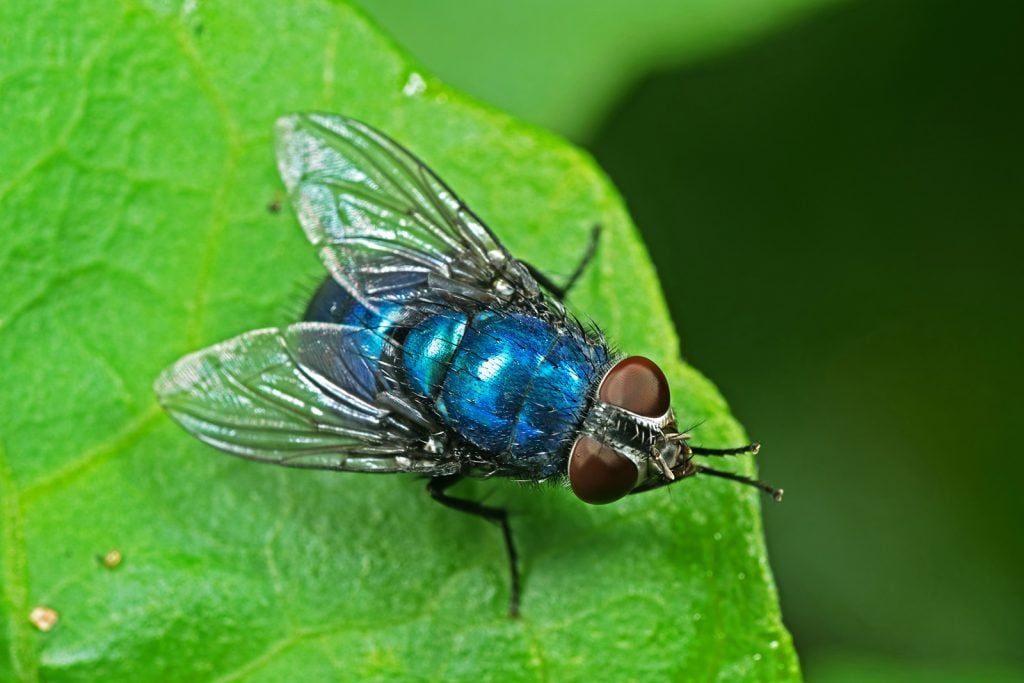
The Blue Bottle Fly or Blue House Fly has a shiny, blue-green carapace and is a bit bigger (and louder) than the average house fly, which makes for a lot of buzzing.
40. Sapphires

Ranging in color from royal blue to a deep midnight blue, Sapphires are precious gemstones that are naturally occurring in similar environments or settings on every major continent.
41. Columbine Flowers
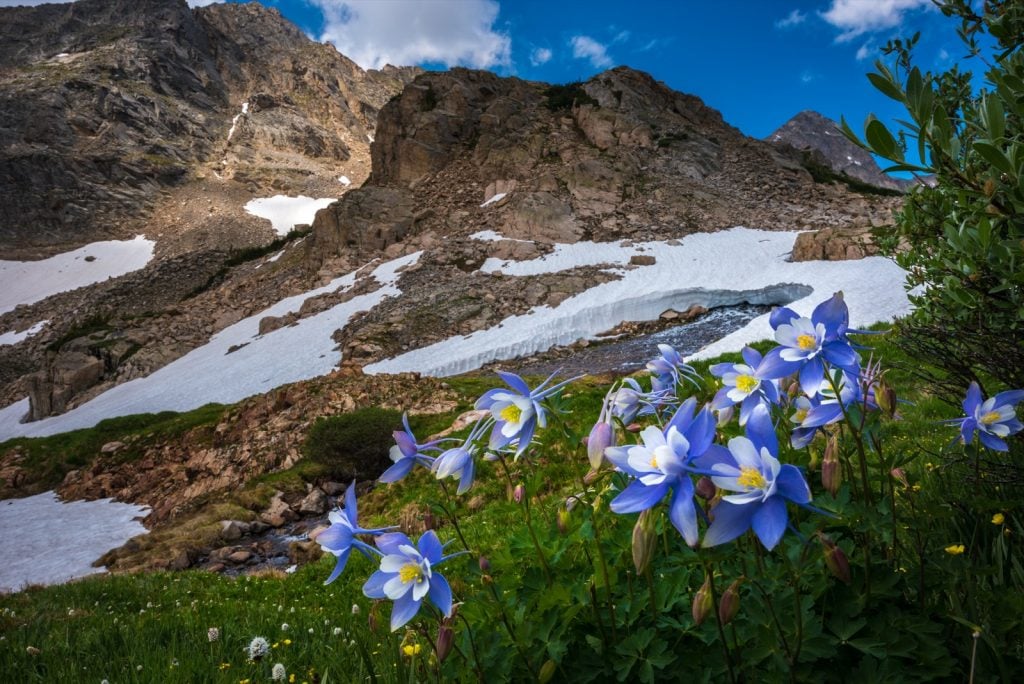
The state flower of Colorado, Columbine Flowers have small, flared, blue and white petals surrounding a head that tilts slightly down towards the perennial plant's leaves and roots.
42. Bluebells

As the name might suggest, Bluebell flowers are shaped like bells. They're very similar to bluebonnets, but the distinctive bell shape is an easy way to differentiate them.
43. Lungwort Flowers

Lungwort flowers tend to land on the sliding scale of blue and purple. Younger flowers are often pink or violet, but they deepen to blue as they mature.
44. Lapis Lazuli

Renowned for its deep, striking color, Lapis lazuli gemstones are found primarily in Afghanistan, Russia, and Chile, with smaller reserves scattered across North America and the Middle East.
45. Honeycreepers
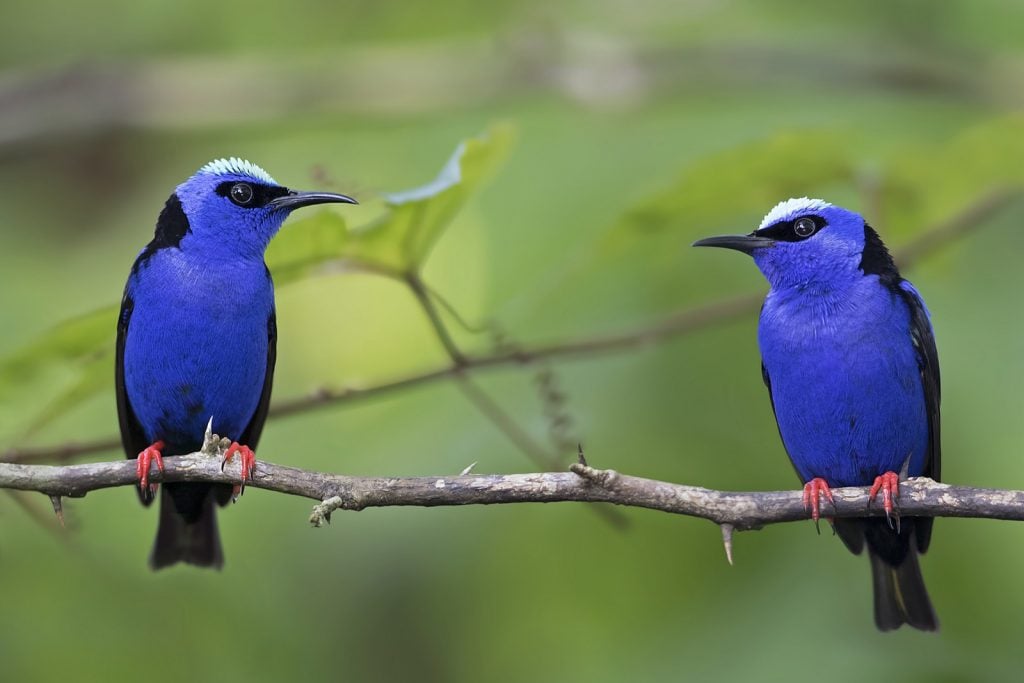
The Honeycreeper is a brilliantly blue songbird that ranges all across South America. It eats insects found on plants, but will often swallow fruits whole as well.
46. Indigo Buntings

Indigo Buntings are small migratory birds that are found all across South and North America. It migrates mostly at night, using the cover of darkness to stay safe.
47. Cerulean Warblers

Another small songbird found in North America, Cerulean Warblers migrate to South America during the winter. The babies and females are often greenish or gray instead of blue.
48. Eastern Bluebirds

Eastern Bluebirds live along the eastern coast of the United States. Beloved by early colonists and modern birdwatchers alike, they are small, round birds with bright blue feathers.
49. Eurasian Blue Tit

Although its unusual name highlights the blue head, back, and wings, the Eurasian Blue Tit also has yellow, black, and white feathers along its head and chest.
50. Blue Dashers

Often seen "dashing" over still bodies of water like ponds, lakes, or even puddles, Blue Dashers are a species of dragonfly with a pale blue, almost metallic body. Several other dragonflies have green or blue-green bodies as well, but the pale blue appearance of the Blue Dasher sets them apart.
51. Campanula

Like the bluebell, the Campanula flower takes its name from its shape.Campanula is Latin for "little bell", which makes sense given the flower's appearance.
52. Aster Flowers
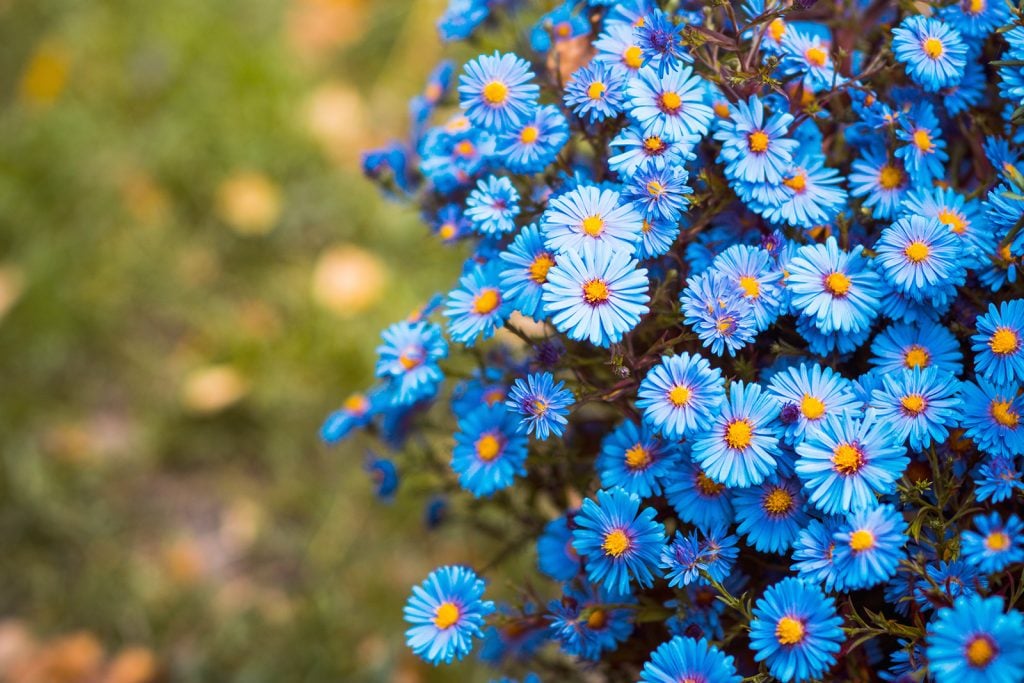
Another shape name, Aster flowers are named for the long, thin petals that stream out like a bright blue starburst, asaster means "star" in Latin.
53. Sea Holly

Sea Holly is a spiky plant that grows by the sea but it can also be grown in the garden. It has flowers that look more like burrs than traditional flowers, with a steely metallic color.
54. Glory of the Snow

The petals of the Glory of the Snow flowers have a purplish blue color at their tips, but fade into white or yellow as they near the center.
55. Starflowers

Starflowers may have sharp, star-like blooms, but the plant is more well-known for the oil extracted from its seeds, high in essential acids and other health benefits.
56. Gentian

A popular choice for acidic or rocky garden soils, Gentian flowers are a very intense blue color. The roots of the flower are often used for flavoring liqueurs.
57. Forget-Me-Nots

They may be called Forget-Me-Nots today, but the scientific name for these pale blue or grayish blue flowers,myositis essentially translates to "mouse's ear" for the flower's soft appearance.
58. Freesia

Freesia flowers come in many colors and grow in a large, upwards-facing funnel shape. It grows from Kenya to South Africa, although it's often cultivated in other places.
59. Centaurea

Another spiny, thistle-looking plant, Centaurea knapweed flowers are actually pretty invasive to North America and can be toxic for animals despite their innocent, pale blue or light purple appearance.
60. Monkshood

With pale blue flowers growing on long stalks, Monkshood is also known as Wolf's Bane or Aconite. It's also one of the most poisonous plants on the planet, dangerous both to humans and animals alike.
61. Bluestripe Garter Snakes

Another instance where the name spoils the surprise, the Bluestripe Garter Snake is a nonvenomous, mostly dark colored snake with a blue stripe running the length of its sides.
62. Electric Blue Geckos

Also known as Turquoise Dwarf Geckos, these bright blue lizards are heavily captured and sold as pets, to the point that they're endangered in the wild.
63. Carpathian Blue Slug
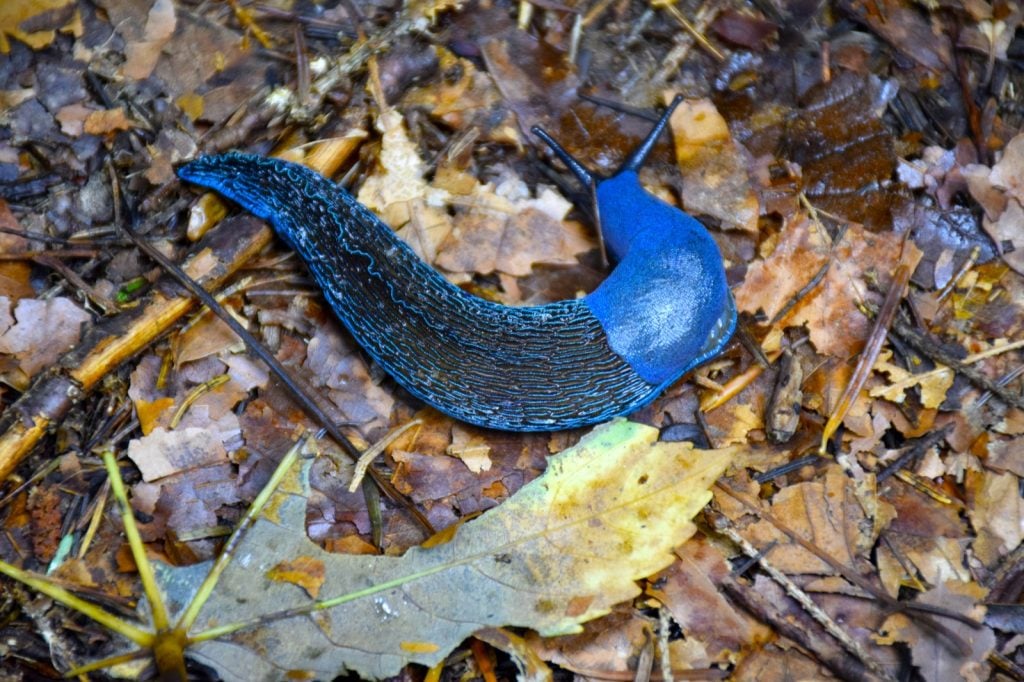
A large slug that lives in the mountains of Eastern Europe, the Carpathian Blue Slug is blue, green or black with a textured back.
64. Calla Lilies

Calla Lilies are most commonly seen in the popular white (wedding) variety, but they come in a wide range of other colors, including a deep purplish blue tone.
65. Love-in-a-Mist Flowers

Love-in-a-Mist flowers have a spiky, almost sharp appearance to their icy blue blooms. Depending on the breed of the flowers, they may come in a much darker hue.
66. Clematis

Technically a part of the buttercup family, Clematis flowers have been popular worldwide since the 1800's, when they were first brought over to Europe from their native Japan.
67. Geraniums

Geraniums are most often found growing in Mediterranean climates. They come in lots of different colors, the most popular being red, but blue blooms are a close second.
68. Pansies
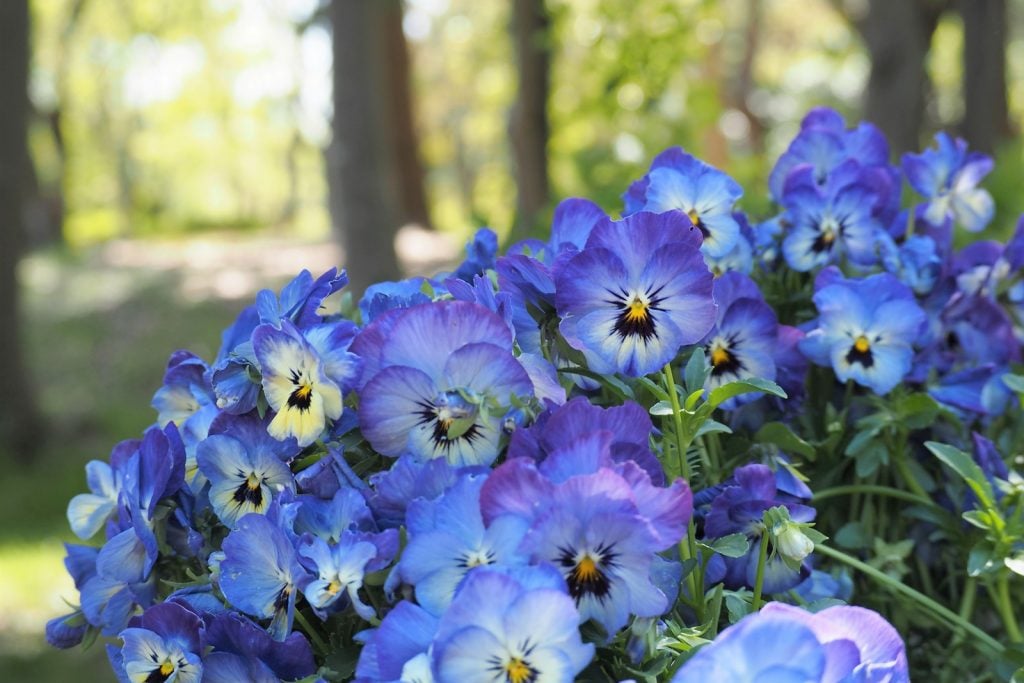
Despite the name, Pansies are an aggressively resilient little plant. Their small, purplish blue flowers bloom in much colder environments than other flowering plants can usually handle.
69. Periwinkle

We call some colors "periwinkle blue" for a reason. The flowers of the Periwinkle plant are a pale, pastel blue tone and they are another popular garden plant.
70. Scarlet Pimpernel
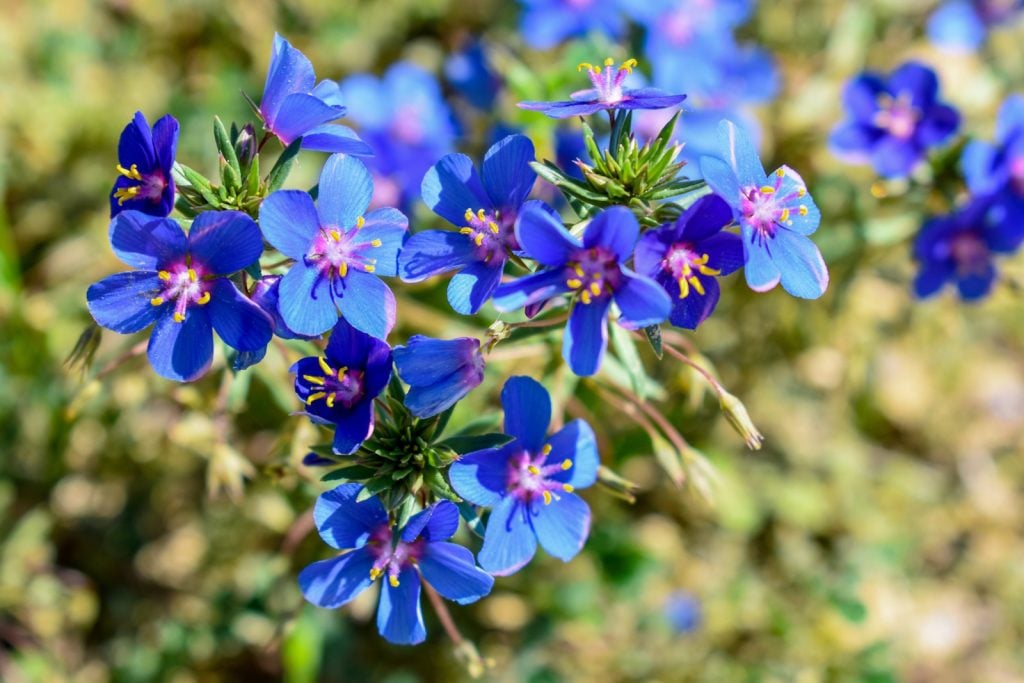
While the name indicates that the reddish orange variety of this plant is more popular, the Scarlet Pimpernel can also come in a deep blue variety whose flowers are similar in color to those of gentian sage. Scarlet Pimpernel is sometimes called the poor man's weatherglass. The plant got its name from its ability to accurately predict the weather. On cloudy days when rain is approaching, its flowers close. On sunny days, they remain open. Though its eye-catching blooms are quite pretty, much of Europe considers the poor man's weatherglass to be a weed.
71. Veronica Flowers

Veronica Flowers are another "spire" flower, which means that it grows a bunch of small flowers surrounding a tall, thin base in order to form a pointed spire.
72. Agapanthus

Sometimes called Lily of the Nile, the Agapanthus plant produces a cluster of thin flowers at the end of several stems in a range of colors including blue.
73. Balloon Flowers

Balloon Flowers are originally native to East Asia, but they have become increasingly popular in the Western world as garden plants, with their many dark blue, star-shaped flowers.
74. Himalayan Blue Poppies

Himalayan Blue Poppies are cheerful, sky blue flowers. They have slightly hairy or fuzzy leaves and are extremely particular about the quality of soil in which they grow.
75. Germander Sage

Germander Sage is actually another variety of the Salvia family. It produces small flowers in a light, smoky blue color and is often used as a ground cover.
76. Blue Daisies

A small, evergreen plant that's originally native to the southern regions of the African continent, Blue Daisies are sweet-looking flowers that have spread all the way to Europe.
77. Corn

Traditionally found in the Southwestern United States, Blue Corn can range in color from a bold, dark blue to a blue so deep that it almost looks black.
78. Indigo Milk Caps

The Indigo Milk Cap is an edible blue mushroom that takes its name both from its strong color and from the white latex it oozes when it's injured.
79. Splendid Fairywrens
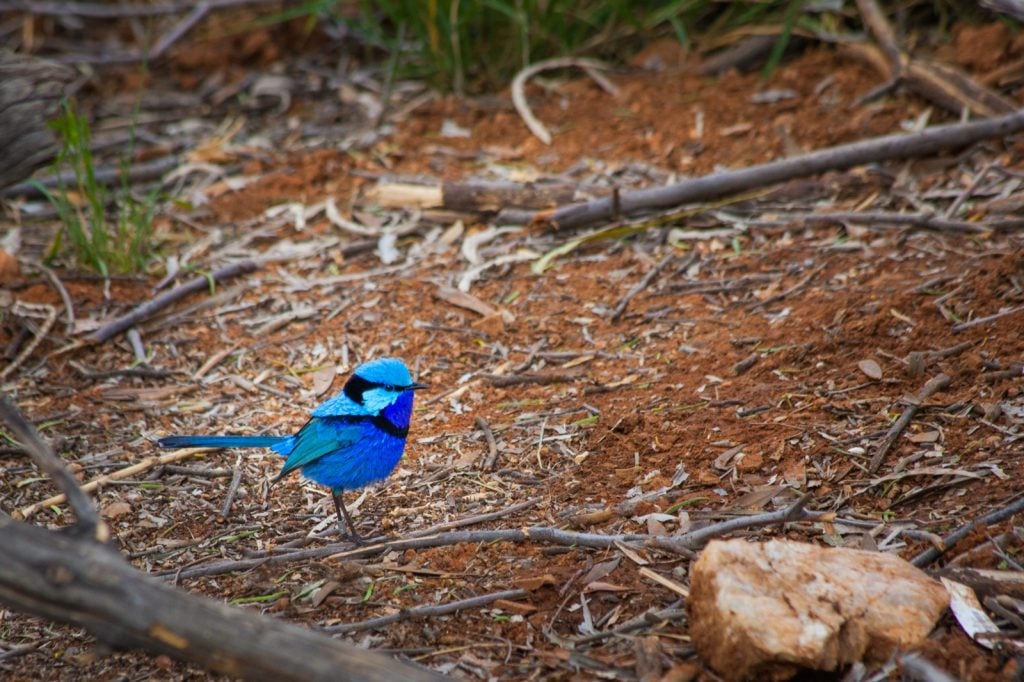
A small songbird native to Australia, the Splendid Fairywren has black markings similar to those of a blue jay around its eyes, but otherwise, it's a rich blue.
80. Butterfly Pea Flower

The Butterfly Pea Flower comes in both blue and white varieties. The blue-colored blossoms are often used to make tea, or in some cases, a color-changing liquor additive.
81. Mountain Bluebirds

Unlike their eastern relatives, Mountain Bluebirds are more turquoise than they are true blue. The females of the species are often yellow, gray, or a dusty white.
82. Blue Clams

Blue Clams are tough specimens that are often found in home aquariums. They can range in color, but are usually a vibrant, electric blue around their shell's opening.
83. Blue Moor Frogs
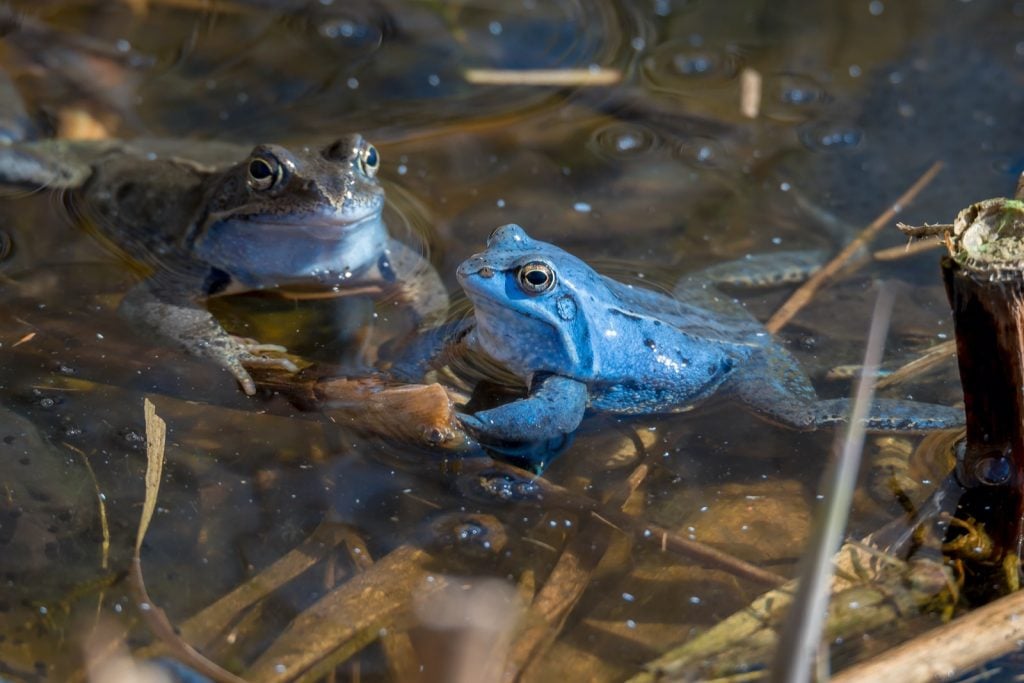
Blue Moor Frogs are usually reddish brown in color. However, during the breeding season, the male frogs will change colors to a bright blue for a few days.
84. Blue-Eared Starlings

The Blue-Eared Starling is a clever bird with a shimmering, iridescent coat. It ranges throughout Africa and prefers to live in woodland environments near open sources of water.
85. Blue Lupines

With indigo blooms growing in sharp-looking spires, Blue Lupines can grow up to two feet tall and are a favorite snack for rabbits and other grazing garden visitors.
86. Blue Humphead Wrasses

Thriving in coral reefs throughout the Indo-Pacific Ocean, the Blue Humphead Wrasse is a large, light blue fish that's heavily endangered due to overfishing and loss of its natural habitat.
87. Flax Flowers

The leaves of the flax are often used for textile work, and the seeds have lots of health benefits, but the flowers are pale blue and quaintly sweet.
88. Black Currants
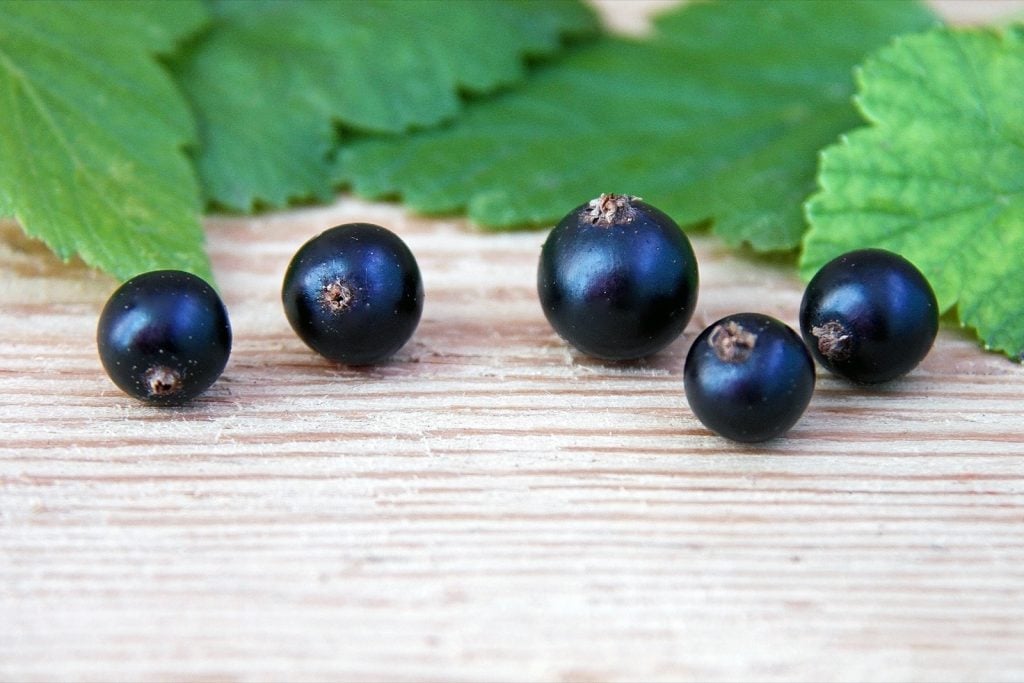
The rich deep blue color of Black Currants means they were used to dye clothes or produce artwork in ancient times almost as often as they were used for food.
89. Blackberries

As the name might suggest, these berries are so dark in color that they look almost black. Nevertheless, the pigment used to color them is actually blue.
90. Damson Plums

Native to Great Britain, Damson Plums have a slightly sour taste and a deep blue, sometimes purple or violet color. They're usually used to make preserves or even dyes for cloth.
91. Concord Grapes

If you've ever had grape jelly, grape candy, or grape soda, you've had Concord Grapes before. On the vine, these grapes have a frosty, almost pale blue color.
92. Elderberries

The Elderberry bush has small, bluish black berries that have been promoted as a cure for just about everything. Whether or not that is true is up for debate, however, they are great for juices, jams and jellies.
93. Irises

Like most of the flowers listed here, the flowers of the Iris can come in many colors, but the curling petals of the blue iris are particularly striking.
94. Delphiniums

Delphiniums grow flowers in long, thin stacks that look somewhat similar to the bluebonnet from a distance. These bright blue prairies blooms are sometimes referred to aslarkspur.
95. Hydrangeas
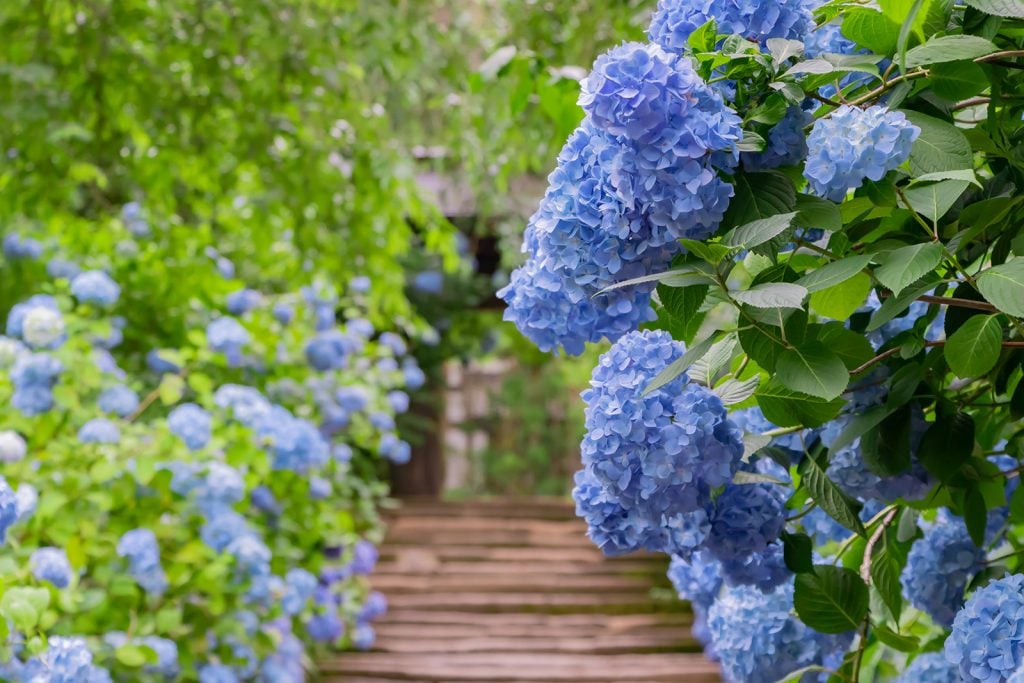
Hydrangeas are extremely popular choices for gardens and front yards alike, and with their large clusters of pale blue or light purple flowers, it's easy to see why.
96. Chicory

The roots may be used for coffee substitutes and the leafs for salads, but the flowers of the Chicory plant aren't good for much – besides their cheerful color!
97. Blue Marble Trees

The Blue Marble Tree may not look particularly blue at first glance. It takes its name from the small, dark blue, marble-looking berries that grow among its branches.
98. Salvia Uliginosa

Not to be confused with the psychoactiveSalvia divinorum,Salvia uliginosa or "bog sage" is a tenacious wetland plant with small, azure blue flowers.
99. Herons

Native to Central and North America, the Great Blue Heron has slate blue feathers that appear gray at first glance, with white feathers along its stomach and chest.
100. Crabs

Different breeds of blue crab are found throughout the ocean. Instead of being fully blue, these animals usually have spots or bands of bright blue along their arms.
101. Blue Jays

Native to North America, these blue, white, and black birds are actually a type ofcorvid, which means that they're part of the larger crow family.
102. Asiatic Dayflower

The Asiatic Dayflower (Commelina Communis) is a single-season creeper plant originating in eastern and southeastern Asia. Though the plant gives bloom to a pleasant blue flower, it is regarded as an invasive species in certain regions of the US and Europe.
103. Indian Breadroot

Found in California, Nevada, and Arizona, the Indian Breadroot or "Beaver Dam Breadroot" is a flowering plant in the legume family. Typically, it grows in local habitats in the desert. It has multiple blue or purple flowers at around one centimeters length.
104. Blue Smoke Bush

The "Blue Brother," or Blue Smoke Bush, is a small shrub descended from West Australia. Its flowers bloom in both winter and spring. It grows low to the ground in thick patches of green leaves, interspersed by outcroppings of its baby-blue flowers.
105. Blue Grosbeak

Male Blue Grosbeaks stand out for their rich blue plumage and barred patterns along their wings. Females are primarily brown in color, with blue accented feathers arranged around their upper bodies.
106. Blue-Throated Mountain-Gem

The Blue-Throated Mountain-Gem is the largest hummingbird found in the United States. Males are recognized for a signature blue patch just below their beaks.
107. Blue Apatite

Blue apatite is a phosphate-based mineral found in various sedimentary and volcanic rocks. Apatite is often used in the production of fertilizer, but its blue variants are sometimes cultivated as gemstones.
108. Dumortierite

To purveyors of crystals and stones, dumortierite is known as a "stone of communication." To the more pragmatically-minded, dumortierite is a valuable component in the manufacture of high grade porcelain. When polished, the blue aggregates of the mineral can mimic the appearance of lapis-lazuli stones.
109. Sodalite

Prized for its dark blue hue and luster, sodalite is a rock-formed mineral regularly used in architectural designs and sculptures. Rock types that support the growth of sodalite are found globally, but are quite rare in general.
110. Blue Tree Monitor

Blue Tree Monitors are found on Batanta Island in Indonesia. Their bodies are actually black – but the layering of their scales creates the appearance of blue rings along the length of their bodies. From afar, this presents the illusion that these monitor lizards are entirely blue.
111. White-Lipped Island Pit Viper

Another Indonesian native, the White-Lipped Island Pit Viper is a venomous snake known for its aggression. While the species is commonly green, the island variants can sometimes be found with arctic blue skin.
112. Blue Panther Chameleon
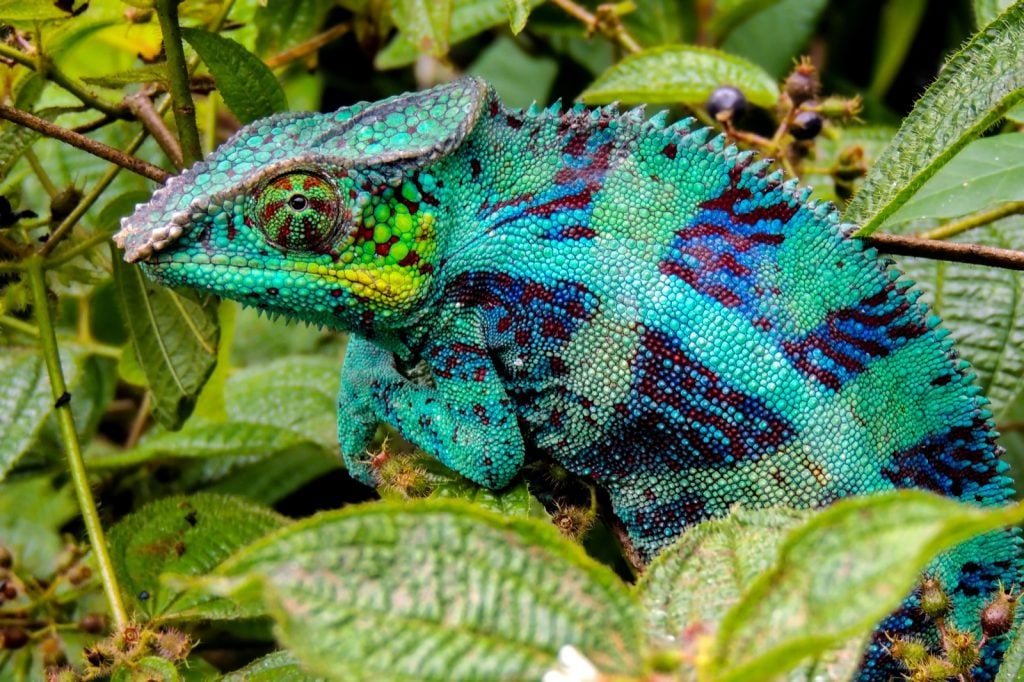
Chameleons are well-loved the world over as pets. In particular, the Panther Chameleon is sought for its ornate markings and lustrous colors – earning it a spot as the most popular pet chameleon variant internationally. They are often seen with beautiful aquamarine and bright blue patterns across their bodies.
113. Parrotfish

One might find the blue-green parrotfish swimming near a coral reef along the shores of the southern Pacific Ocean. These beaked fish provide crucial maintenance on reef structures by recycling coral bits and moderating algae growth. The resulting excrement generates the famous white sands of the nearby beaches. A single parrotfish can produce up to one ton of sand annually.
114. Blue Sea Sponge
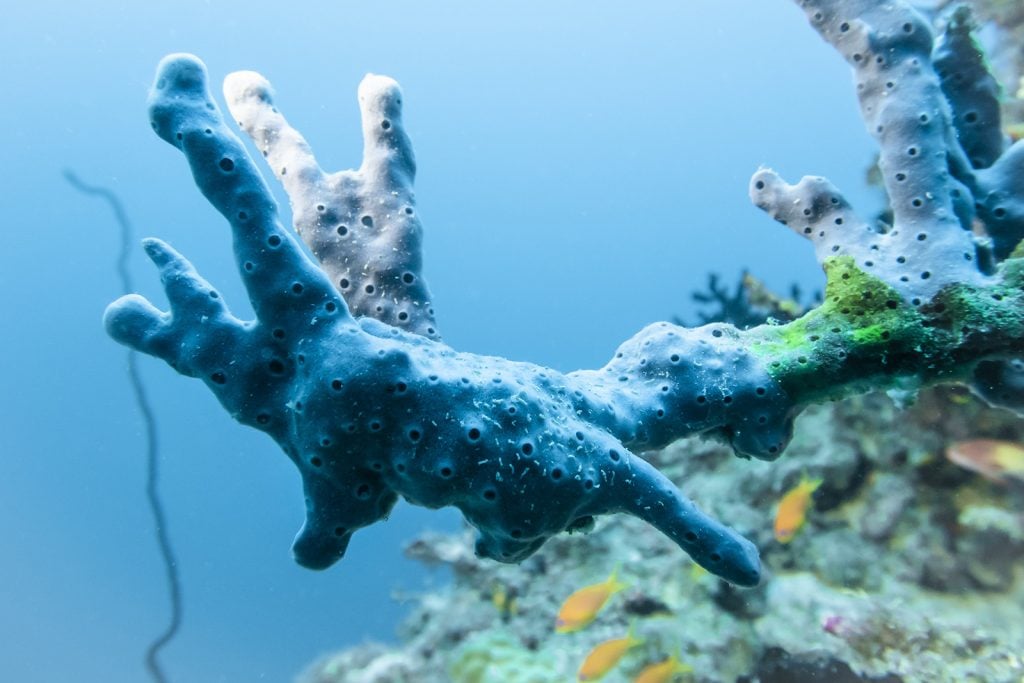
Sea sponges come in many shapes, sizes, orientations and textures. The blue sponge is frequently selected for aquariums due to its vibrant royal blue color. They're non-photosynthetic and subsist on phyto- and zooplankton.
115. Blue Jellyfish

The Blue Jellyfish can be found drifting along the United Kingdom's coastlines searching for bounties of summer and fall-time plankton. The jellyfish's other nickname – "Bluefire" – owes to its blue, fire-like interior enveloped by a milky white body.
116. Blue Supergiant Stars

Blue supergiant stars are luminous wonders of the night sky – contributing to a significant portion of the stars visible by the naked eye. Blue light carries a high frequency wavelength which correlates to brightness in the visible light spectrum. The high energy and heat emissions of blue supergiants means they live shorter lives relative to stars of other colors.
117. Ring Nebulas

Ring nebulas are formed when a star is in the last stage of its development. The Blue Ring Nebula was discovered in 2004 by NASA's GALEX space telescope. The origin and nature of the nebula was the subject of constant research for nearly two decades, when researchers settled on it forming through the merging of two stars. The "stellar merger" event resulted in a tremendous amount of gas being released; represented in telescopic photos as ultraviolet blue light.
118. Planet Earth

Green is not the only important color of Earth. Planet Earth has also been called the "Blue Planet" due to the amount of water on its surface. More specifically, about 71 percent of the surface is water-covered and 96.5 percent of this water is in the oceans.
119. Blue Soil Hills of Sagada

One of the Philippines' lesser known marvels can be found near the Marlboro Hills of Sagada. The Blue Soil Hills are tucked away in a stretch of ancient limestone formations. The blue tint of the soil comes about through high concentrations of copper in the earth, and consistent moisture saturation year-round. The blue-tinted hills are protected and preserved by local communities, but travelers are free to visit.
120. The Great Blue Hole

The "Great Blue Hole" off the coast of Belize is one of the most famed scuba diving locations in the world. The landmark is a sinkhole surrounded by an atoll formation. It is over 400 feet deep and more than 1000 feet across. The hole's depth provides a dark navy blue tone to the water above it.
121. Blue Asteroids

Asteroids are generally observed to be red, yellow, gray, or orange in color. Blue asteroids are regarded as especially rare by cosmologists. Asteroids tend to lack the surface composition to produce a blue coloration. One asteroid, Phaethon, seems to have achieved its blue coloration by orbiting exceptionally close to the sun. The close proximity heats Phaethon to nearly 1500 degrees Fahrenheit, essentially cooking the superficial mineral layers of the asteroid into a pale blue color.
122. Blue-Tailed Skinks

If you've ever seen little black lizards with blue tails sitting in the sun, you've probably seen blue-tailed skinks. They have unusual coloring. Their bodies are black with bright yellow stripes, and their tails are bright blue. The tails serve an important purpose. If a skink is in danger of being eaten, they can drop their tail. There is also a species of blue-tailed skink native to Australia. These lizards look a lot like the North American skinks, but they are often a little brighter in color. Blue-tailed skinks are sometimes kept as pets, especially in Australia.
123. Kyanite

Kyanite is a blue mineral that you can most often find in metamorphic rocks. It usually forms in blue, blade-like crystals that can sometimes be a deep blue similar to sapphire. For that reason, kyanite can occasionally be used as a gemstone. More often, though, it's used to make very strong porcelains. Porcelains made with kyanite tend to be extremely heat-resistant, making them ideal for use for insulators on spark plugs and similar applications. It is also sometimes used in dentures and toilets.
124. Blue Roan Horses

Blue roan horses have coats made of half white hairs and half black hairs. This mix creates a distinct bluish-gray color. Most blue roans have black faces and legs, giving them an especially striking color. There are a few different types of roans. One example is the red roan, a horse with a chestnut and white coat. Blue roan coloring can occur in almost every breed of horse. It's especially prevalent in mustangs, quarter horses, Welsh ponies, Paso Finos, and Tennessee walking horses. Interestingly enough, Arabians and Thoroughbreds haven't been shown to actually carry the roan gene.
125. Blue Swallowtail Butterflies

These beautiful butterflies are some of the most easily recognizable insects in North America. You may have also seen the yellow swallowtail, a type of butterfly whose wings are yellow instead of blue. The blue mountain swallowtail has beautifully glistening blue wings lined in black. The bottom of the wings extend downward like the tail of a swallow, hence the name. Blue swallowtails taste very bitter to predators, so they are largely left alone in the wild.
126. Mandarin Dragonets

Mandarin dragonets are incredibly bright fish that are sometimes appropriately called "psychedelic mandarinfish." Their bodies are a bright blue with a striking orange pattern and a wavy, ribbonlike orange tail. In the wild, these tropical fish mostly live in the western Pacific near Australia and the Philippines. Thanks to their bright color, these fish are sometimes kept as pets in saltwater aquariums. But these fish are best left to experienced keepers. They tend to prefer live food, and it can be difficult to fulfill all their nutritional needs in captivity. Interestingly, the mandarin fish's large, bulging eyes make it look a little like a frog.
127. Bright Blue Begonias

The name of the bright blue begonia may make you picture vibrant blue flowers. But this beautiful plant has a trait that's much rarer. Instead of being the typical green, its leaves have a deep blue hue. In some types of lighting, this begonia's leaves still look green, but the blue is unmistakable when the light catches them at certain angles. Most experts believe that the blue leaves help the plant absorb more sunlight. That's because they are native to parts of Malaysia where there's very little sunlight. These plants thrive in very humid areas, making them a great choice for your garden if you live in the South.
128. Kettle Ponds

These blue, unusual bodies of water are common in Cape Cod and surrounding areas. The kettle ponds formed after the ice age. As glaciers melted away, they left enormous hollows in the earth that later filled up with fresh water. Some of the larger ponds in the area are popular beaches for locals and visitors alike.
129. Six-Lined Racerunners

These slender, quick-moving reptiles look almost like fish on land. And they're much faster than most other lizards. Six-lined racerunners can sprint up to 18 miles per hour if needed. While they are not entirely blue, male racerunners have pale blue bellies and throats. Females have whitish bellies, and most racerunners are either dark green, black, or brown. This species is named for the six yellow-green stripes extending down the body.
130. Gentian Sage

If you're looking for a shock of bright blue for your garden, then gentian sage might be a good addition. In contrast to many blue blooms that are a softer shade of blue, gentian sage flowers are a deep, radiant blue that looks especially nice next to yellow or orange flowers. Though they originated in the Mexican mountains, these plants have found popularity thanks to the deep and pure blue color of their flowers.
131. Blue Glaucus

This small species of sea slug is also sometimes called blue sea dragon or blue sea slug. They float upside down at the ocean surface which works as a countershading camouflage. The blue side of their body blends in with the blue of the water and their gray underside blends in with the reflection of sunlight. The blue glaucus has a painful and potentially dangerous sting, even to humans.
132. Florida Scrub-Jays

These bright blue birds are the only species in the U.S. that only lives in Florida. They look a little like a mix of a blue jay and a bluebird. The head, tail, and wings are blue, with the rest of the body being a whitish-gray. Scrub-jays are unusually family-oriented birds. Until they find their own territory, grown offspring assist their parents in raising new chicks. They rarely venture far from where they were hatched, and they don't migrate.
133. Blue Crested Lizards

Many blue animals found in nature are native to Asia, and blue crested lizards are as well. They are sometimes called the Indochinese forest lizard. During most of the year, blue crested lizards have mostly reddish-brown bodies. But during the breeding season, both males and females develop bright sky blue heads and necks, and that bright blue also shows up part of the way down the body. And as the name suggests, they also have spiky crests starting at the neck and going down the back. Blue crested lizards also have a white stripe on the sides of their heads. Despite their striking looks, they aren't usually kept as pets.
134. Harvest Bells

Few eastern wildflowers are as striking in color as the harvest bell. These are flowers native to North Carolina, and they grow especially well in sandy soil. They have shiny, deep green leaves that end at a point. Their flowers are a purplish blue that's close to periwinkle in color, and they grow on top of the plant's often tall stems. Harvest bells are also a great way to add some interest to the garden. They bloom in September, so they can keep a garden blooming after most plants have stopped.
135. Blue Mockingbirds

The blue mockingbird is a deeper-blue counterpart to the grayish-brown mockingbirds found in much of the U.S. It lives primarily in thickets in Mexico, but you may occasionally see one or two in Arizona. And despite the name, it's not very closely related to the northern mockingbird. These birds are a deep slate blue with a black patch extending from the eyes to the base of the beak. Blue mockingbirds are also called Melanotis Caerulescens. They have a call similar to that of a catbird, and their build and plumage are somewhat similar as well.
136. Butterfly Blue Scabiosa

This scabiosa variety produces delicate violet-blue, pincushion-like flowers that sit at the top of long green stems. The butterfly blue scabiosa blooms for months from spring through summer, and as their name suggests, these flowers can attract butterflies to the garden.
137. Blue Diamonds

Diamonds might just be the most coveted rocks on earth, and they come in many colors. Blue is among the rarest. Blue diamonds can only be found in India, Australia, and South Africa. And though some may think that blue diamonds are chemically treated to change the color, the blue in them is all-natural and comes from traces of boron in the initial carbon that formed the diamond. You can find blue diamonds in three levels of color intensity. "Fancy light" is a diluted blue-gray, "fancy" is moderate blue, and "fancy intense" is a deep blue that's a lot like sapphire.
138. Pencil Surgeonfish

Even if you've never heard of surgeonfish, you've already seen one. Dory, the sidekick in theFinding Nemo movies we mentioned earlier, is a species of surgeonfish called Blue Tang. The Pencil Surgeonfish is another variety. Surgeonfish get their name from their spines. They are sharp and resemble a scalpel in shape. These spines are sharp enough to cut you if you touch them. The most beautiful surgeonfish are a vibrant blue with bright yellow accents. Some species are easygoing and easy to care for, making them great aquarium pets. If you'd like to see a surgeonfish without owning one, they can often be found in coral reefs.
139. Spix's Macaw

These beautiful birds are also known as little blue macaws. Unfortunately, they are incredibly rare. They are classified as being extinct in the wild. In fact, the birds were already rare when they were first discovered in 1819. They are the only known small blue parrots. But thanks to the number of Spix's macaws in captivity, there are currently efforts underway to eventually repopulate the birds' natural habitat in Brazil. They look a little bit like a more colorful version of an African gray parrot. They have pale blue-gray heads and darker blue-gray bodies.
140. Blue Rainbow Lizards

These small, colorful lizards are also known as the common agama. They are primarily native to Ethiopia, although their bright colors and relative ease of care mean that they can sometimes be kept as pets. It's somewhat unusual in that non-dominant males have coloring similar to that of females and juveniles. Females and non-dominant males are a duller, olive-like color. Dominant males are the brightest. They usually have a blue body and a yellow or orange head and tail. In terms of temperament, blue rainbow lizards tend to be relaxed and laid back, except in the case of dominant males defending their territory.
Things That Are Blue in Nature
Again, a lot of the objects listed above tend to contain more gray or purple than what we'd typically consider blue. This list of blue things is here to remind us just how special the color blue is. Blue is one of the rarest colors found anywhere in nature, which is a big part of what makes these plants, animals, celestial bodies, and natural phenomena so very unique.
Read Next: 51 Things That Are Turquoise in Nature
Source: https://www.color-meanings.com/things-that-are-blue/
Post a Comment for "Things That Are Blue List Things That Are Blue"